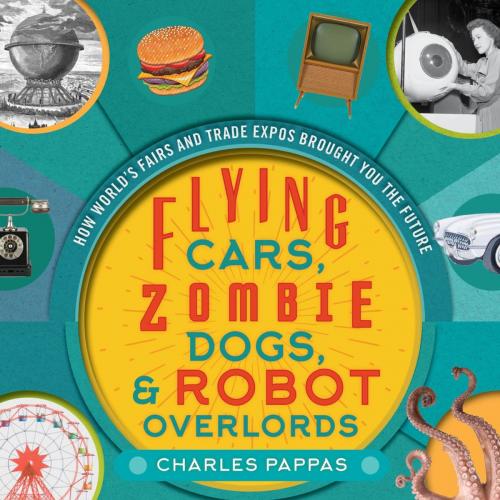
Every time you chew a stick of Juicy Fruit, eat a hamburger, slip on a nylon, plug your phone into a wall socket, flick on a TV, withdraw money from an ATM, lick an ice-cream cone, switch on a computer, ride an escalator, play a DVR, watch a movie about dinosaurs, or pop a tranquilizer, you’re doing something that originated at a world’s fair or trade expo. In fact, each new technology and every novel product that rocked America and rolled the world, from the Colt revolver and the Corvette to fax machines and flush toilets, started at trade fairs, a $100 billion industry that includes world expos, trade shows, and state fairs. More than just promoting material things, however, trade fairs popularized and evangelized every social movement and cultural concept, too, including Manifest Destiny, the closing of the frontier, Nudism, Nazism, Fascism, eugenics, female suffrage, temperance, and technocracy. While there have been notable works on world’s fairs by Robert Rydell, Erik Larsen, Erik Mattie, and others, they only capture a fragment of the whole mosaic of these shows—a mosaic that makes the glitziest Las Vegas spectacle look like an Amish barn-raising. This amusing book covers, for example, the World’s Fair that featured a nudist colony (1935); Salvador Dali’s half-naked lobster women, their virtue barely secured by well-placed crustaceans (1939); a model of the Liberty Bell made of Oranges (1893); one of Thomas Edison’s lesser-known inventions, the prefabricated concrete home (1907); and the Bayer Company’s experiment with selling heroin. More memorable and culturally iconic debuts discussed here include electricity, radios, the Volkswagen and the Corvette, television, the X-ray machine, air conditioning, and even nylon stockings. Dozens of short, illustrated chapters take the reader through over 150 years of world and trade fairs, from the vibrators displayed by sexual health advocates at the 1900 World’s Fair to the first true IMAX film at Expo ’70 in Japan.
Every time you chew a stick of Juicy Fruit, eat a hamburger, slip on a nylon, plug your phone into a wall socket, flick on a TV, withdraw money from an ATM, lick an ice-cream cone, switch on a computer, ride an escalator, play a DVR, watch a movie about dinosaurs, or pop a tranquilizer, you’re doing something that originated at a world’s fair or trade expo. In fact, each new technology and every novel product that rocked America and rolled the world, from the Colt revolver and the Corvette to fax machines and flush toilets, started at trade fairs, a $100 billion industry that includes world expos, trade shows, and state fairs. More than just promoting material things, however, trade fairs popularized and evangelized every social movement and cultural concept, too, including Manifest Destiny, the closing of the frontier, Nudism, Nazism, Fascism, eugenics, female suffrage, temperance, and technocracy. While there have been notable works on world’s fairs by Robert Rydell, Erik Larsen, Erik Mattie, and others, they only capture a fragment of the whole mosaic of these shows—a mosaic that makes the glitziest Las Vegas spectacle look like an Amish barn-raising. This amusing book covers, for example, the World’s Fair that featured a nudist colony (1935); Salvador Dali’s half-naked lobster women, their virtue barely secured by well-placed crustaceans (1939); a model of the Liberty Bell made of Oranges (1893); one of Thomas Edison’s lesser-known inventions, the prefabricated concrete home (1907); and the Bayer Company’s experiment with selling heroin. More memorable and culturally iconic debuts discussed here include electricity, radios, the Volkswagen and the Corvette, television, the X-ray machine, air conditioning, and even nylon stockings. Dozens of short, illustrated chapters take the reader through over 150 years of world and trade fairs, from the vibrators displayed by sexual health advocates at the 1900 World’s Fair to the first true IMAX film at Expo ’70 in Japan.















